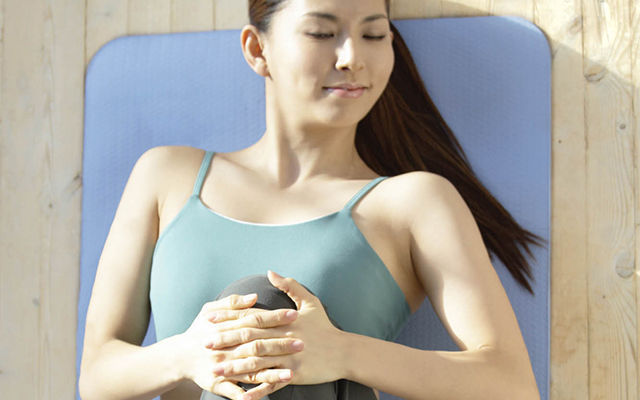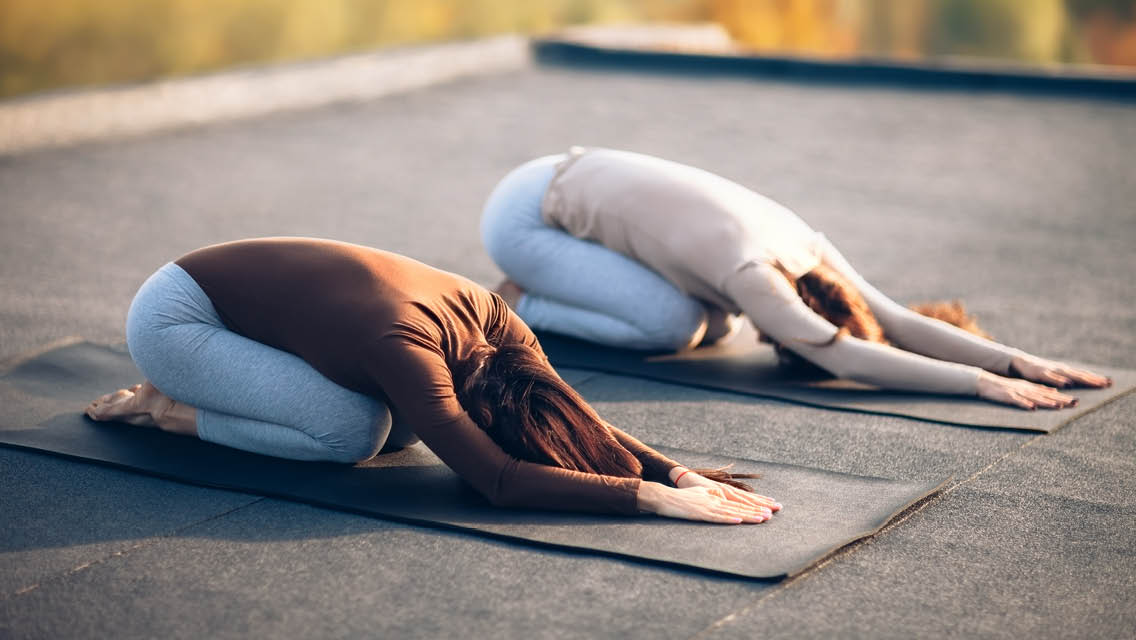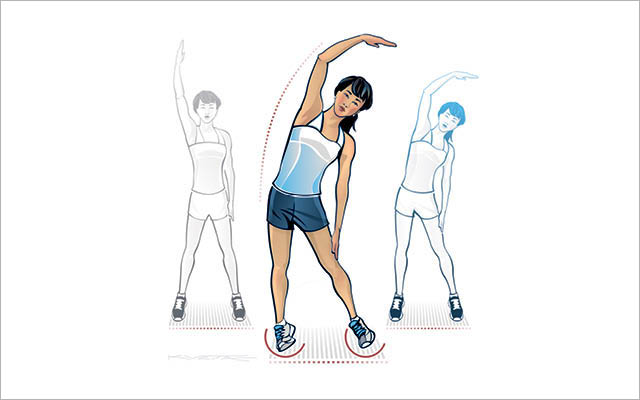First thing in the morning there’s nothing more pleasurable than stretching out with a luxurious, writhing yawn. Drawing oxygen into your lungs and simultaneously wringing out your muscles – the way many of us do upon waking – is the most instinctive form of stretching. And if we lived in a natural state and followed our body’s instincts more often, perhaps it’s the only form we would need.
“Unfortunately, our lives have become restricted and sedentary,” says Dr. Thomas Green, a chiropractor in Lincoln, Neb. “When our bodies get lazy, our muscles atrophy and our joints settle into a limited range.” Many of us choose to counterattack the ravages of a comfortable life with rigorous exercise. But doctors like Green point out that activity alone won’t fill the bill.
Even if you remain active, your body dehydrates and stiffens with age. By the time you become an adult, your tissues have lost about 15 percent of their moisture content, becoming less supple and more prone to injury. Likely injuries include not just pulled muscles and strained joints, but tiny, cellular micro-injuries – the kind that leave you sore after plucking weeds or pumping iron. Over time, these tiny injuries add up, creating layers of scar tissue that gradually restrict movement even further.
Stretching slows the process of dehydration by stimulating the production of tissue lubricants. It also pulls the interwoven cellular cross-links apart and helps muscles rebuild themselves with a healthier parallel cell structure. This helps us create a longer, sleeker form, but perhaps even more important, daily stretching provides a heightened sense of body awareness. It also delivers the sheer pleasure of unrestricted movement – if you do it right!
Stretch-Fest
So, what is the “right” way?
It all depends on what you want to achieve. There isn’t one exercise that will make you “flexible” in the same general way that running can improve your overall cardiovascular health. Rather, flexibility training represents the flip side of resistance training: It requires a similar, muscle-by-muscle approach, an individualized, body-by-body strategy. And like strength training, flexibility training has recently gone high-tech: The art of loosening up muscles and joints has now evolved into a scientific enterprise with an advanced methodology and an attitude all its own.
You may have noticed that a lot more people at the gym these days are stretching, and stretching more creatively. If you witness someone doing a flexibility routine that looks unfamiliar, eccentric or even downright nutty, don’t assume they’ve gone round the bend.
It is possible they’re just borrowing stretches from their Ashtanga yoga class, or practicing some state-of-the-art form of stretching, such as forced relaxation or contrast stretching. They might also be doing sport-specific stretches prescribed by a coach or physical therapist. Or perhaps they’re working on releasing deep muscles, the isolation and extension of which can require some pretty odd body positions.
Should evidence of all these newfangled flexibility-training techniques lead you to believe you’ve fallen out of touch with current stretching technologies, don’t despair. There are lots of books and videos that can help you get up to speed! In the meantime, take a few moments to learn the basics.
Stretching 101
Flexibility can be broadly categorized under two general classifications:
Functional flexibility refers to your range of movement without assistance. An example of this would be lifting your leg straight out in front of you like a ballet dancer. Most healthy people of average flexibility can lift their leg to 90 degrees or slightly less. A trained ballerina, on the other hand, might be able to raise her leg, unassisted, into a full 180-degree standing split. She has what we would call maximum functional flexibility.
Static flexibility is the type most often associated with traditional stretching. It refers to one’s range of motion using the aid of gravity, a partner or the pull of an opposing body part. It doesn’t require muscular control, just lack of resistance. A floor “split” is an example of a posture requiring maximum static flexibility.
An example combining both types of flexibility is the classic toe-touch. The difference between how far down you can reach unassisted, versus the extent of your stretch when you grasp your ankles or toes and pull, represents the difference between your functional and static flexibility.
Best of Both Worlds
A basic knowledge of stretching can help you select the right flexibility exercises for your specific objectives. Research has shown that functional (sometimes called “dynamic”) flexibility training translates more readily to athletic achievement, while static stretching is best for remodeling connective tissue. Therefore, a complete flexibility program should combine both dynamic and static stretching. One way to achieve this balance is to incorporate dynamic stretching into your pre-workout warm-up routine and static stretches into your post-exercise cool down.
Pre-Exercise: Functional Stretching
Begin with 10 minutes of aerobic warm-up on a treadmill or stationary cycle to increase your heart rate and deep-muscle temperature. This increase in warmth, joint-fluid viscosity and blood flow prepares the body for the dynamic movements of functional stretching.
Next, choose your motion. Your pre-exercise stretching period should essentially mimic the movements of your target athletic activity, but in a slower and more exaggerated manner. For example, runners can perform long walking strides or leg swings that emphasize hip extension to stretch the hip flexors. Lifters can rotate their arms in long, slow, sweeping arches to lubricate the delicate shoulder joints and loosen the deltoids.
While performing dynamic stretches, it’s important to avoid sudden movements and bouncing because ballistic actions like these tend to trigger a physiological response known as the “stretch reflex.” This reflex is designed to protect you from sudden, joint-damaging movements and acts like the automatic catch on your seatbelt: Move too fast and it stops you cold. Because ballistic stretches tend to activate this reaction, they can actually increase stiffness.
According to Russian flexibility expert Pavel Tsatsouline, “a properly performed dynamic stretch is terminated right before the stretch reflex fires.” When you respect this limit, Tsatsouline explains, the threshold that triggers this reflex gradually backs off. So each time you stretch, you’ll find you can move a little farther before your muscles recoil.
Post-Exercise: Static Stretching
Static stretching involves stretching to the farthest point you can without strain, then holding this position for 15 to 30 seconds. Then, as you breathe and relax, your stretch increases slightly. You can then hold this new position for another 15 seconds.
Post-workout static stretching can optimize your range of motion because exercise boosts the elastic properties of connective tissues, making them more receptive to lengthening. Then, as your muscles cool down in the stretched position, they actually retain their extended length.
Some experts claim that post-exercise stretching also reduces delayed muscle soreness and prevents the development of cross-cellular scar tissue. Recent studies indicate post-exercise stretching even promotes strength, possibly because stretching supports faster recovery.
When you perform a static stretch, the pulling sensation you feel in your muscles comes primarily from the elongation of your muscle fascia – the connective tissue that invests and surrounds your muscles to give them structure and form. Static stretches work on lengthening this connective tissue and, to a lesser extent, the underlying muscle fibers.
Because they are built for movement, muscle and fascia can stretch without losing tone, like a coiled telephone cord that stretches, but then snaps back to its resting length. Tendons and ligaments can’t do this. This is why you should never perform forced, painful stretches, which can permanently deform non-elastic tendons; and avoid twisting and hyperextending joints, which can become lax from overstretching.
The best way to avoid hurting yourself while stretching is to track your movements along natural joint angles and back off when you feel any sharp pain, especially if near a joint.
This article originally appeared as “Flex and Flexibility.”




This Post Has One Comment
Informative! You give the reader a good framework to understand the basics. Recommendations for more in-depth discussion of static and functional flexibility would give the reader a segue to more knowledge.